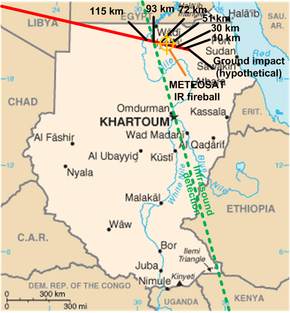
Back 2008 TC3 Bulgarian 2008 TC3 BS 2008 TC3 German 2008 TC3 Spanish 2008 TC3 Finnish 2008 TC3 French 2008 TC3 Hungarian 2008 TC3 ID 2008 TC3 Italian 2008 TC3 Japanese
 | |
| Discovery | |
|---|---|
| Discovered by | Catalina Sky Survey |
| Discovery date | October 6, 2008, 06:39 UTC |
| Designations | |
| 2008 TC3 | |
| Orbital characteristics[1] | |
| Epoch October 7, 2008 (JD 2454746.5) | |
| Uncertainty parameter 4 | |
| Observation arc | 1 day (575 observations) |
| Aphelion | 1.71644 AU (256.776 Gm) |
| Perihelion | 0.899957 AU (134.6317 Gm) |
| 1.308201 AU (195.7041 Gm) | |
| Eccentricity | 0.312065 |
| 1.50 yr (546.53 d) | |
| 330.7541° | |
| 0.6587071°/day | |
| Inclination | 2.54220° |
| 194.101138° | |
| 2008-Nov-20 | |
| 234.44897° | |
| Jupiter MOID | 3.57975 AU (535.523 Gm) |
| Physical characteristics | |
| Dimensions | 4.1 meters |
| Mass | 80 tonnes (80,000 kg) |
Mean density | ~1.5 g/cm3 |
| 0.0269409 h (1.61645 min)[1] | |
| 0.1±0.03 | |
| F/M | |
| 30.4[1] | |
2008 TC3 (Catalina Sky Survey temporary designation 8TA9D69) was an 80-tonne (80-long-ton; 90-short-ton), 4.1-meter (13 ft) diameter asteroid[2] that entered Earth's atmosphere on October 7, 2008.[3] It exploded at an estimated 37 kilometers (23 mi) above the Nubian Desert in Sudan. Some 600 meteorites, weighing a total of 10.5 kilograms (23.1 lb), were recovered; many of these belonged to a rare type known as ureilites, which contain, among other minerals, nanodiamonds.[2][4][5]
It was the first time that an asteroid impact had been predicted before its entry into the atmosphere as a meteor.[6]
- ^ a b c "JPL Small-Body Database Browser: (2008 TC3)" (last observation: October 7, 2008; arc: 1 day). Jet Propulsion Laboratory. Retrieved March 28, 2016.
- ^ a b Jenniskens, P.; et al. (2009). "The impact and recovery of asteroid 2008 TC3". Nature. 458 (7237): 485–488. Bibcode:2009Natur.458..485J. doi:10.1038/nature07920. PMID 19325630. S2CID 7976525.
- ^ Plait, P. (October 6, 2008). "Incoming!!!". Bad Astronomy. Archived from the original on October 7, 2008. Retrieved October 8, 2008.
- ^ Chang, K. (March 25, 2009). "Recovered Pieces of Asteroid Hold Clues to Early History". The New York Times. Archived from the original on November 13, 2013. Retrieved March 26, 2009.
- ^ Borenstein, S. (March 26, 2009). "Astronomers catch a shooting star for 1st time". ABC news. The Associated Press. Archived from the original on March 29, 2009. Retrieved September 15, 2009.
- ^ Roylance, F. (October 7, 2008). "Predicted meteor may have been sighted". Maryland Weather. Archived from the original on October 10, 2008. Retrieved October 8, 2008.